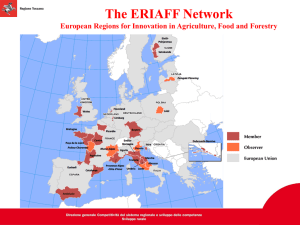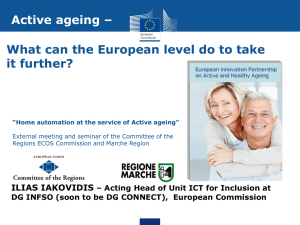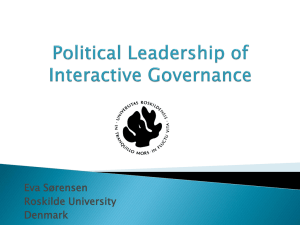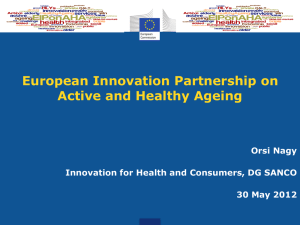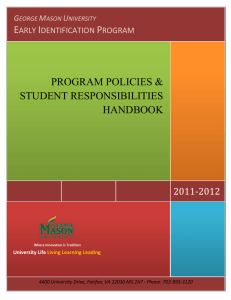Application Form for Expression of Commitment to
advertisement
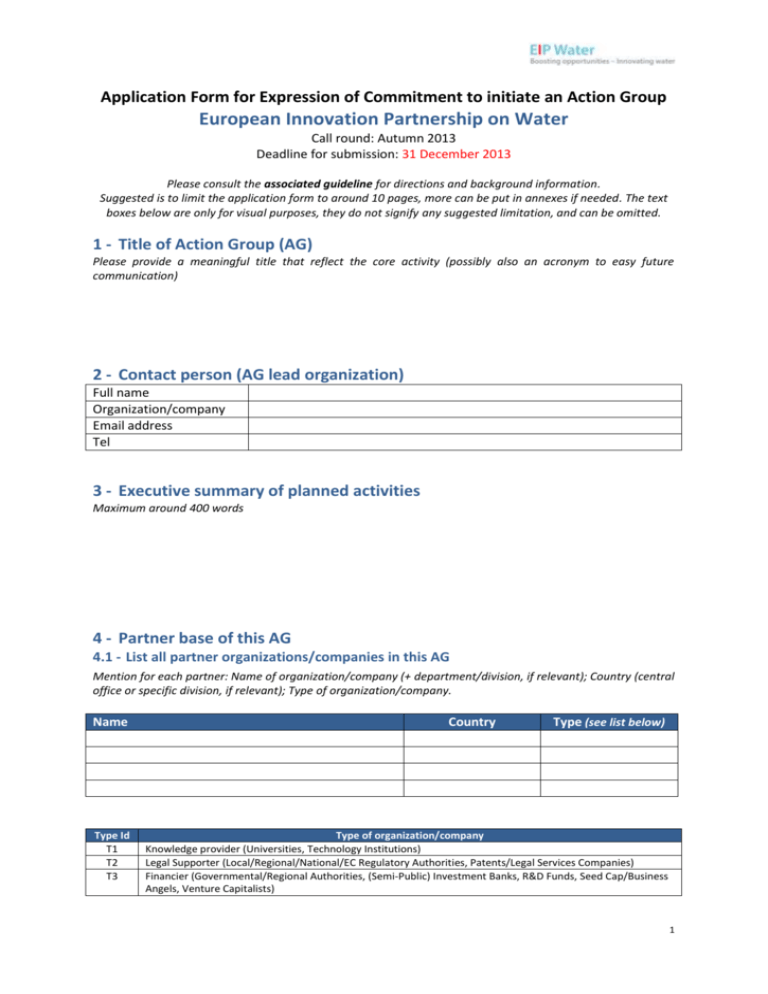
Application Form for Expression of Commitment to initiate an Action Group European Innovation Partnership on Water Call round: Autumn 2013 Deadline for submission: 31 December 2013 Please consult the associated guideline for directions and background information. Suggested is to limit the application form to around 10 pages, more can be put in annexes if needed. The text boxes below are only for visual purposes, they do not signify any suggested limitation, and can be omitted. 1 - Title of Action Group (AG) Please provide a meaningful title that reflect the core activity (possibly also an acronym to easy future communication) 2 - Contact person (AG lead organization) Full name Organization/company Email address Tel 3 - Executive summary of planned activities Maximum around 400 words 4 - Partner base of this AG 4.1 - List all partner organizations/companies in this AG Mention for each partner: Name of organization/company (+ department/division, if relevant); Country (central office or specific division, if relevant); Type of organization/company. Name Type Id T1 T2 T3 Country Type (see list below) Type of organization/company Knowledge provider (Universities, Technology Institutions) Legal Supporter (Local/Regional/National/EC Regulatory Authorities, Patents/Legal Services Companies) Financier (Governmental/Regional Authorities, (Semi-Public) Investment Banks, R&D Funds, Seed Cap/Business Angels, Venture Capitalists) 1 T4 T5 T6 T7 T8 Innovation Supporter (Innov Councils, Incubators, Testing Facilities, Expert Group Agencies) Water User (Water Distribution Companies/Authorities, Treatment Plants, Large Industry/Agricultural/Domestic Consumers, Water Management Authorities) Technology Company (Treatment Service, Equipment/System Manufacturers/Suppliers, Infrastructure Service, Engineering, Intermediate-Other Services/Suppliers) Promoter (Water Sector Associations, User Lobby Groups, NGOs, Social/Public/Environmental Organizations) Other (Other, Non Water Sector) 5 - Description of planned activities 5.1 - Select the core EIP W priority area that this AG aims to focus on Please select one EIP W priority area from table 1 at the end of this form and enter here (Id or full text). 5.2 - Select secondary EIP W priority areas that this AG aims to work on (if applicable) If applicable select one or more EIP W priority areas from table 1 at the end of this form and enter here (Id or full text). 5.3 - Describe which specific innovation barriers will be addressed in the work of this AG 5.4 - Describe the action plan, with deliverables and milestones 6 - Innovative concepts 6.1 - Describe innovative concepts in the works of this AG, e.g. by envisioned product, service, a/o delivery channel and new practices or markets (or in the case of thematic cross-cutting activities: describe the envisioned enhancement of the framework, e.g. in regulation or finance) 2 6.2 - Describe how the envisioned results compare to existing solutions that may be similar or adjacent (added-value of the envisioned results of this AG) 6.3 - Provide reference to available work-to-date (e.g. used policy studies, feasibility studies, market research, draft business plans) 7 - Relevance and urgency 7.1 - Describe likely demand or market potential (or in the case of thematic cross-cutting activities: describe indirect demand/market effects) of envisioned outcomes and results of this AG 7.2 - Describe the replication potential for roll-out in (other (sub-) sectors, other regions and countries 7.3 - Which partner(s) in this AG will be directly involved with the dissemination and marketing of the results 3 7.4 - Provide reference to likely 3rd parties that could help in the dissemination and marketing of the results (No firm commitment will be required with those 3rd parties) 8 - Governance 8.1 - Describe how the internal governance of this AG is foreseen 8.2 - Describe if IPR considerations are planned (and if so, which) -=-=-=-=- 4 Annex - Table 1 Priority Id P10 P11 P12 P13 P14 P20 P21 P22 P23 P24 P30 P31 P32 P33 P40 P41 P42 P43 P50 P51 P52 P60 P61 P62 P63 P64 P70 P71 P72 EIP W Priority areas WATER RE-USE AND RECYCLING - Fit for Purpose/Symbiotic approaches based on technical, economic, social and environmental criteria, where cost-effective treatment meets intended use and quality. - Innovative solutions and/or treatment options, producing and testing recycled/reclaimed water for residential, urban, industrial and agricultural uses, with consideration of ecosystems and involving multiple stakeholders. - Systems capable of determining the quality of recycled and reclaimed water to improve management and public acceptance according to health requirements. - Innovative separation- and extraction technology pilot projects in industrial zones to harvest resources from waste- and re-used water. WATER AND WASTE WATER TREATMENT - Innovative concepts for (alternative) water supply, wastewater treatment and recovery of resources. - Source control methods for discharges of emerging pollutants and pathogens into the wastewater treatment system and cost-effective on-site technologies, removing as much as possible at source. - Water treatment innovation hubs, in regions that currently lack of appropriate sewer systems and treatment and sanitation facilities, applying smart technologies and decentralized systems with a focus on alternative water sources. - Systematic approaches to avoid loss of water, energy and resources in industrial production and water and wastewater infrastructure. WATER-ENERGY NEXUS - Approaches for reducing energy consumption related to drinking water production, wastewater treatment, industrial water use, and irrigation for agriculture. - Innovative and widely applicable solutions for energy recovery and/or surplus energy production both from water in natural systems as well as from anthropogenic water use. - Develop and demonstrate widely applicable concepts and solutions for water use related to energy production, urban and industrial hot/cold water systems. FLOOD AND DROUGHT RISK MANAGEMENT - Innovative extreme event prevention and protection tools, including sensor technology and monitoring networks, forecast and early-warning systems in urban, rural, riverine and coastal areas, for support of policy, land-use planning and emergency management. - Innovative mitigation and adaptation measures to minimize climate change impacts, including the role of natural ecosystems and their protection. - Integrated risk assessment and management approaches, ranging from planning to implementation of new insurance policies, bringing together the physical, economical, insurance, emergency management and social factors, based on resilience and social vulnerability and ensuring social acceptance. ECOSYSTEM SERVICES - Methodologies for valuation of and payment for ecosystem services, including tangible and intangible services. - Innovative management schemes addressing water related ecosystem services in Europe and non-European countries. WATER GOVERNANCE - Innovative forms of governance that connect across boundaries of regions, policy sectors, jurisdictional levels and timescales, and that simultaneously involve the public and raise public awareness. - Partnership models which link private sector governance, such as certification, stewardship and round tables, to public sector water governance with a view to achieve sustainable water management in lowincome countries and emerging markets. - Water pricing policies based on innovative approaches, where the over-user pays principle is added to the polluter pays principle, defining clear and measurable efficiency targets for each area of activity at the relevant level. - Interventions to overcome barriers in the governance systems that hinder development and uptake of innovations. DECISION SUPPORT SYSTEMS AND MONITORING - Smart water management systems with export potential, based on multi-sourced data platforms including quality and quantity monitoring, data management and modeling. The platforms should include data sources from water cycle and data sources from other interconnected domains. - Interconnection of smart sensor based monitoring networks, crowd-sourcing, localized and other smart information dissemination and data management to enhance operational services. Annex – page 1 Priority Id P73 P74 P80 P81 P82 P83 P84 P90 P91 EIP W Priority areas - Model and monitoring standards for the global water cycle with integration of all water cycle aspects (ecological, environmental, economic, social) to establish a leaders’ role in the export market. - Well targeted monitoring and analysis of drinking, waste and process water to enhance decision making. FINANCING FOR INNOVATION - An EU wide common structure to build interfaces between funders, industry, companies, SMEs and research organizations to foster relationships promoting innovation and improve knowledge about access to finance. - Options to improve access to finance for SMEs active throughout the water cycle, especially those with potentially disruptive technologies and those with high export potential. - Frameworks and instruments to stimulate public sector innovation in the priority areas identified by the EIP, based on a review of public procurement best practices in relevant sectors of industry in Europe and other OECD countries. - Innovative financial instruments at an EU level to support European companies proposing innovative goods and services and to facilitate access into overseas water sector export markets in line with the objectives of the EIP. SMART TECHNOLOGIES - No separate actions are defined for Smart Technologies, as they are identified as a key enabler for the EIP W priorities. Smart Technologies have been integrated in the actions of the priorities, where applicable. Annex – page 2



